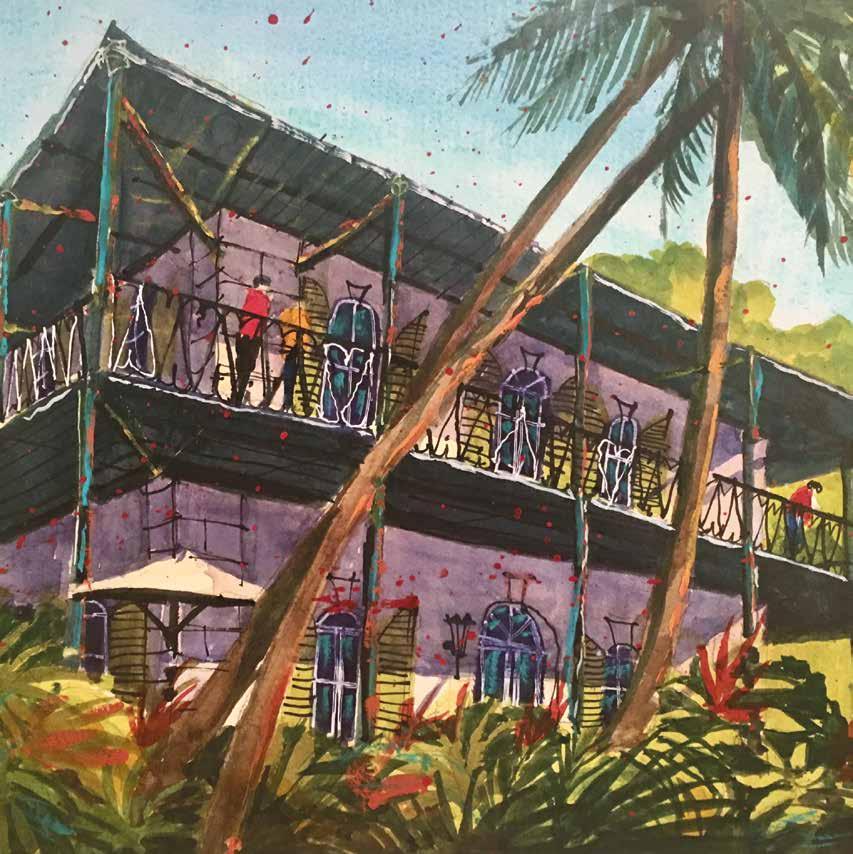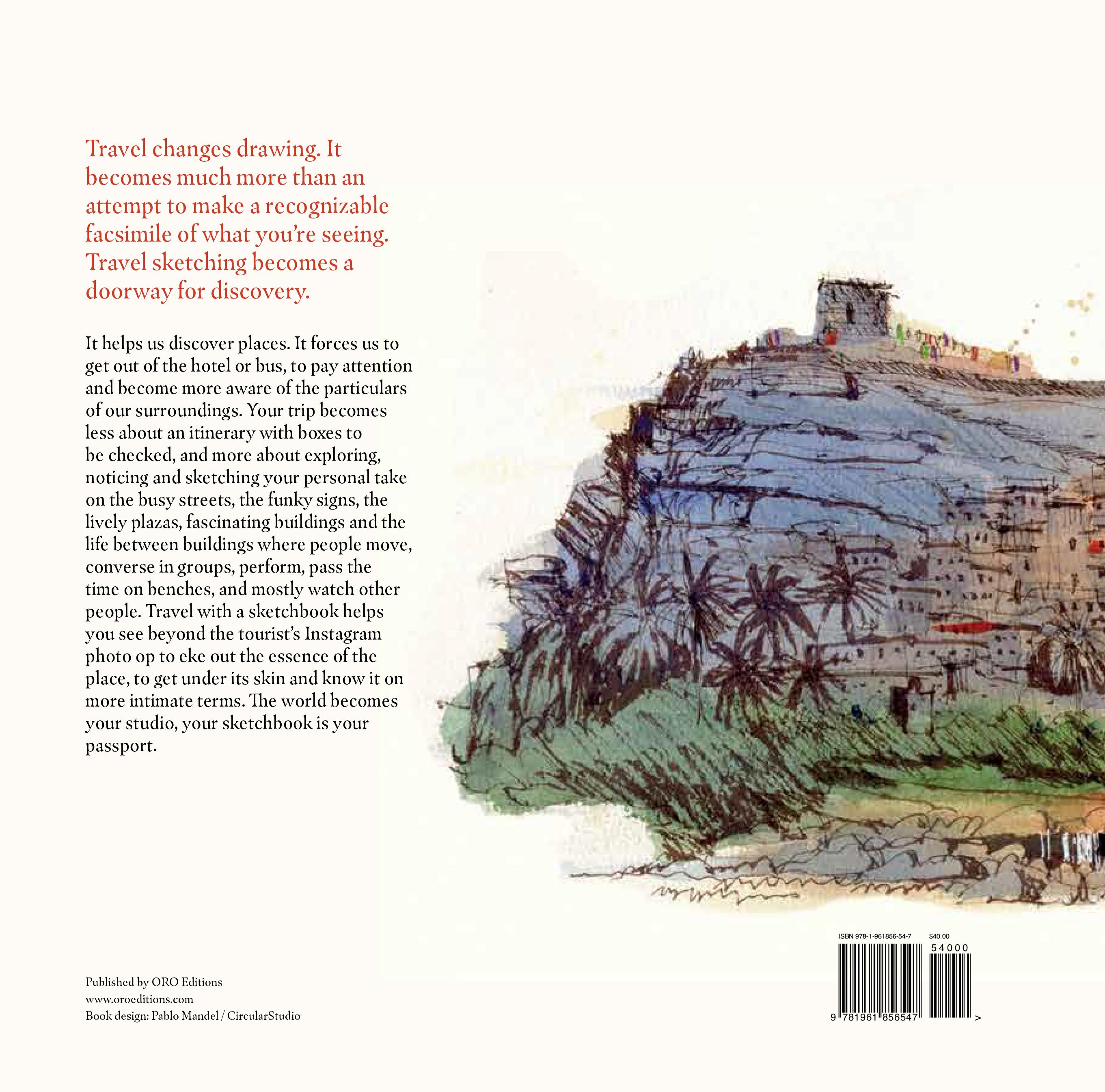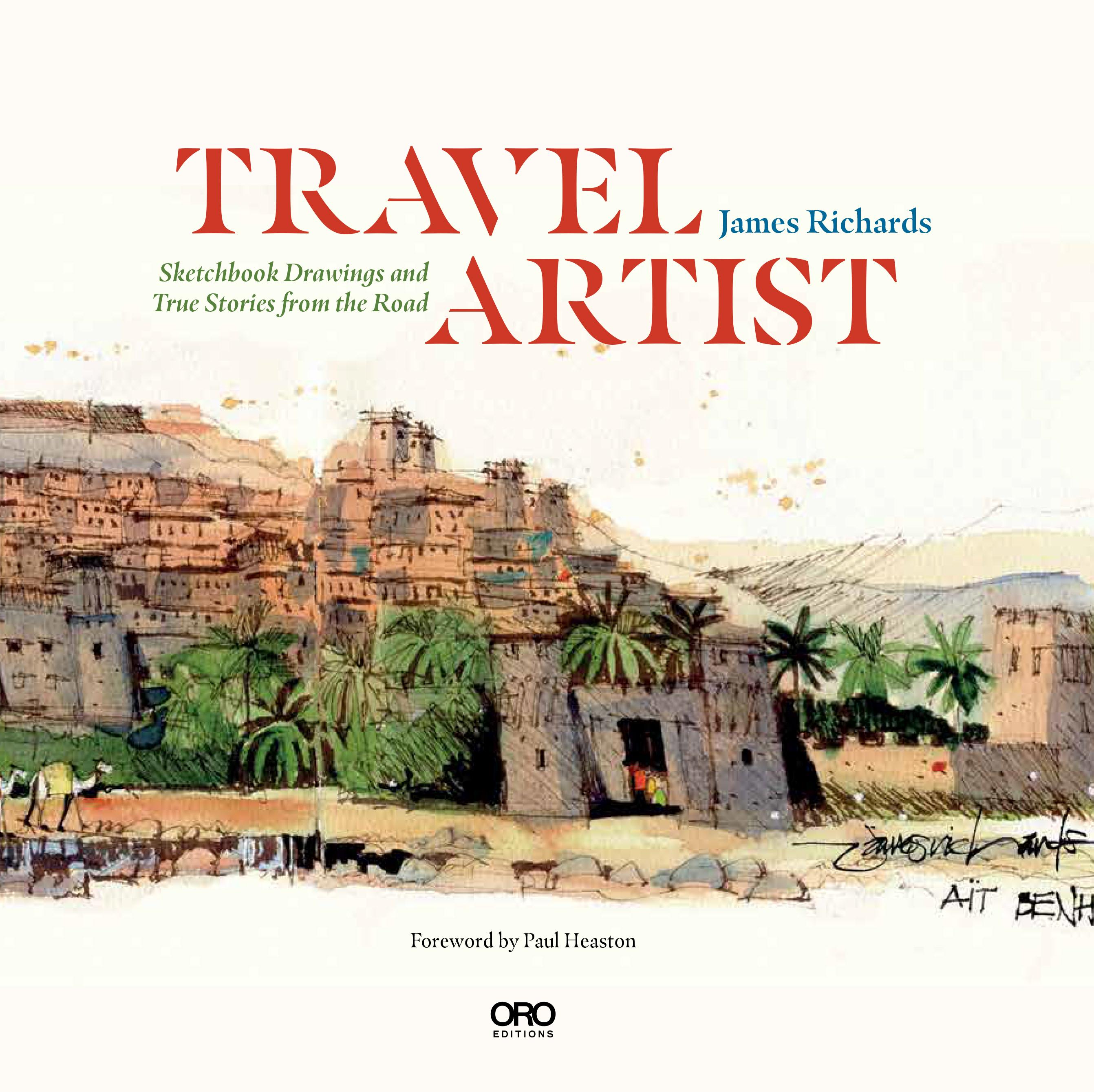






Foreword by Paul Heaston
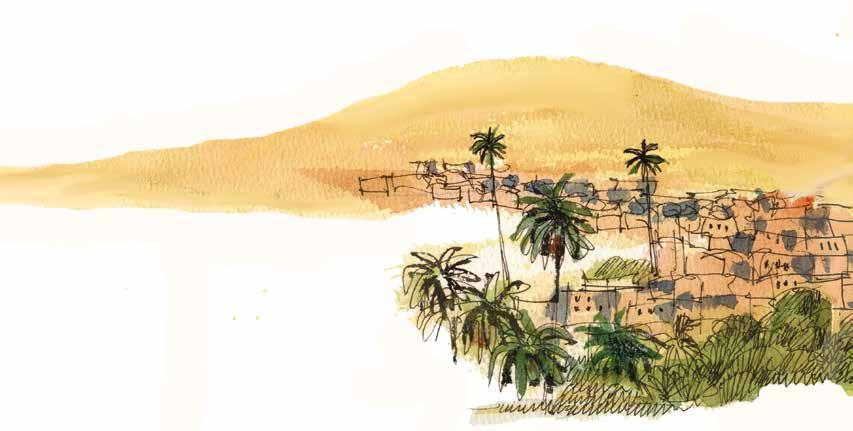
Foreword by Paul Heaston
Acknowledgments
Introduction
The Sketcher's Code: Don't Aspire to be Great
1
Early Influences
The Sketcher’s Code: It’s Not about Art.
It’s about Authenticity
Chapter 2
Tuscany: One Table, One Family, One Community
The Sketcher’s Code: Don’t Worry about Style
Chapter 3
Cuba: Hemingway’s Muse
The Sketcher’s Code: Have an Idea
Chapter 4
Cuba: Busted in Havana
The Sketcher’s Code: Notice Everything
Chapter 5
Baja California: Whales of Magdalena Bay
The Sketcher’s Code: Keep It Loose
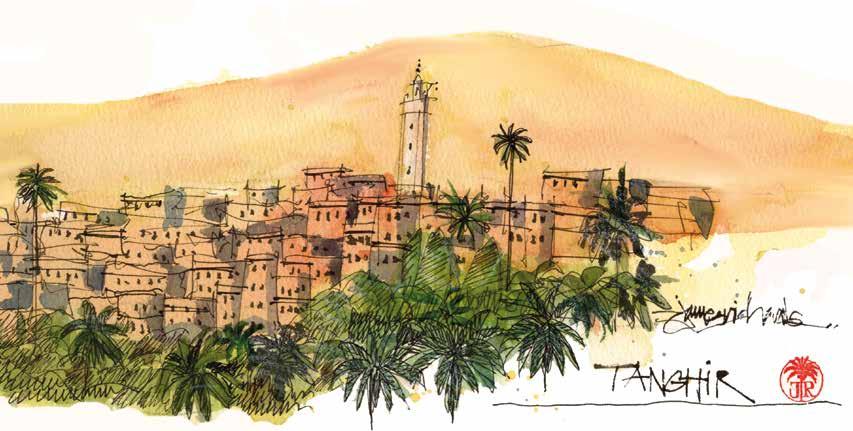
Chapter 6
Vietnam: Ambushed by Beauty
The Sketcher’s Code: Don’t Touch
the Monkey!
Chapter 7
Morocco: Looking for Different
The Sketcher’s Code: We Don’t Need
No Stinking Rules
Chapter 8
Kenya: Through Ancient Eyes
The Sketcher’s Code: Be Cool
Chapter 9
Key West: The End of the Road
The Sketcher’s Code: Finish on the Spot. Or Not.
Afterword: Following the Voice

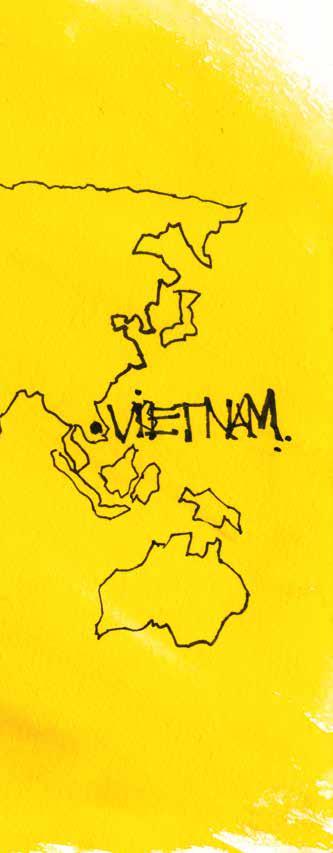
Is it Art? Doesn’t matter.
I never saw myself as Monet in the studio. I wanted to be Anthony Bourdain with a sketchbook.

I’v E claim E d squatt E r’s rights on a favorite little piece of French Quarter sidewalk at the corner of Royal and St. Peter. It’s prime real estate for street musicians, but I’ll be gone before they wake up. For now, it’s mine. My back’s against the brick wall of the historic LeBranche House, drawing in the sketchbook on my lap. It’s one of those mornings when my brain is engaged, eyes and hand are in sync, and the lines and tones seem to draw themselves. I’m liking this one, and I’m surprised at how quickly it’s coming together.
I picked this spot because it has a great view of Royal Street in the very early morning—the Royal Street tourists never see. Locals of every description mill in and out of the neighborhood grocery store in the historic building across the street. The studio apartment above, with its ornamental iron railing dripping with carnival beads, lush collection of potted plants and a funky, life-sized sculpture of a pink flamingo looking down on happenings below can’t help but make you grin. Delivery guys are pushing hand trucks up the street, and local shop owners are hosing down their sidewalks. Residents who live above the ground-floor shops and galleries are walking their dogs. See, this is really a neighborhood. That’s what I hope to capture in this sketch.
I feel someone behind me. “Whoa! Did you just do that?”
“Uh, yeah.”
“I mean, you drew that while you’re sitting here?”
“Yeah.”
“Man, how long did it take you to do that?”
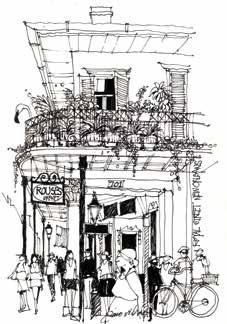
Opposite: Heathrow Airport, London.
Top: Royal Street, New Orleans.
“Fifty years.”
“What? Wait, oh yeah, I get it. No, really, how long? You know, it’s weird. I’ve never paid that much attention to that building before. I mean, I’ve never seen it like I’m seeing it here. That’s cool! Know what I mean? Hey, do you know where I could get a good breakfast?”
“Half a block this way on your right.”
This was New Orleans, but it could have been Rome, Istanbul, Rio or a village in Vietnam. One more real place is in the sketchbook. One more person is looking at a place a little differently. That’s my job.
It didn’t start with the idea that becoming a vagabond artist was a shrewd career move. It started with a sketchbook and a cheap pen. Now, 20 years later, I’m unpacking from 13 days in Morocco, with dogeared pages of drawings and stories, and wondering how my grown-up and respectable career somehow morphed into visiting 50-odd countries, drawing in sketchbooks, and how I became someone different in the process.
Over the previous two weeks, my adventurous cadre of sketchbook artists and I had experienced a Morocco that a tourist with a camera would never see. That’s because drawing changes travel. It turns up the intensity and pulls you fully into the moment. We look more deeply and see more clearly. And because we’re looking for scenes that, when drawn, collectively tell a story, the journey becomes more purposeful.
Conversely, travel changes drawing. It becomes much more than an attempt to make a recognizable facsimile of what you’re seeing. Travel sketching becomes a doorway for discovery.
It helps us discover places. It forces us to get out of the hotel or bus, to pay attention and become more aware of the particulars of our surroundings. Your trip becomes less about an itinerary with boxes to be checked, and more about exploring, noticing and sketching your personal take on the busy streets, the funky signs, the lively plazas, fascinating buildings and the life between buildings where people move, converse in groups, perform, pass the time on benches, and mostly watch other people. Travel with a sketchbook helps you see beyond the tourist’s Instagram photo op to eke out the essence of the place, to get
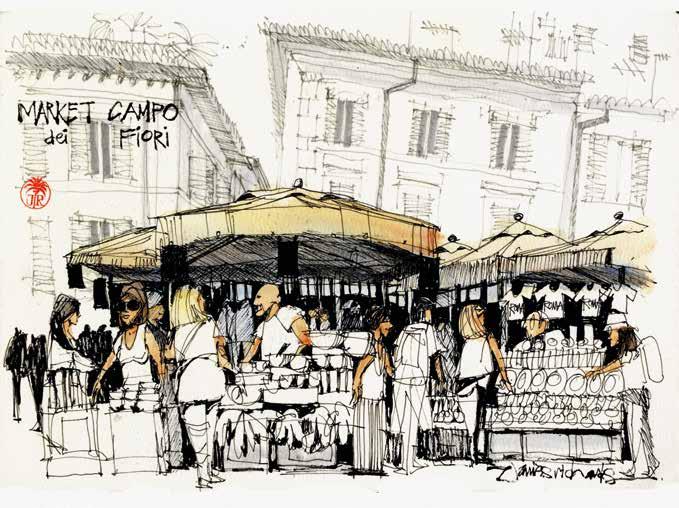
Morning market, Rome.
under its skin and know it on more intimate terms. The world becomes your studio, your sketchbook is your passport.
Now, twenty years later, I’m unpacking from 13 days in Morocco, with dog-eared pages of drawings and stories, and wondering how my grown-up and respectable career somehow morphed into visiting 50-odd countries, drawing in sketchbooks, and how I became someone different in the process.
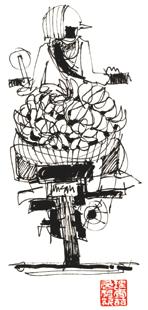
Vietnam.
Travel sketching helps us discover connections. Where a stranger with a camera on a local street away from home may raise suspicion or resentment, a sketchbook raises curiosity. It opens doors to conversations with locals and other travelers. They may share insights into the place. They may share personal stories. They may comp your mojito or buy your cabrito taco from the street cart. These personal encounters expand the experience of travel beyond what any tour guide can tell you. That’s because drawings are a universal language that can transcend normal barriers of distance, language and ideology. It’s drawing with a mission. Many times, I’ve been told by locals, “You’ve made me see my own place with fresh eyes!” That’s really cool. And it’s a very good reason to draw.
Finally, travel sketching helps us discover something of ourselves. If you let it, sketching changes you. You may tap into a latent talent. You may reconnect with that kid inside you that drew just because you felt great when you did it. Certainly, you see places differently. You notice more, and the more you sketch, the more you see. You become more aware, and awareness is everything. You start to pay attention to the aged stone in the architecture, the details in ornamental ironwork, patterns in the tile paving, dappled sunlight through the trees. You quickly sketch the accordion player serenading anyone who will allow him to. You doodle the noisy red tuk-tuk at the stop light. You learn to see the remarkable in the everyday. It’s all around us, all the time, but you have to be tuned into it. Sketching helps you do that.
As your informal drawings accumulate, your sketchbook becomes a priceless, self-illustrated retelling of your travels. Some drawings may be small, quickly scrawled thumbnail sketches made with a ballpoint pen, or informal freehand maps of the day’s itinerary. Others may have been done with more detail, maybe even with watercolor washes. There may
be notes, and a streetcar ticket or beer label glued onto the page. Taken together, they tell a personal story of what you saw and how you saw it, captured to best of your ability at the time. And because they’ve been drawn in your own hand, they’re uniquely yours in a way that a camera’s snapshot can never be.
So, Morocco is in the books. It’s currently the latest stop in my version of what Bob Dylan calls his “Never Ending Tour”—fifty countries so far, more to come. The seven chosen for this volume represent some variety of experiences, some geographic diversity, and frankly, are the ones I thought would make a good book. Now, it’s time to clean the fountain pens, replace the watercolor tubes that are squeezed dry, look over the maps with my wife Patti (henceforth known here as “The Grownup”) and start thinking about the next one.
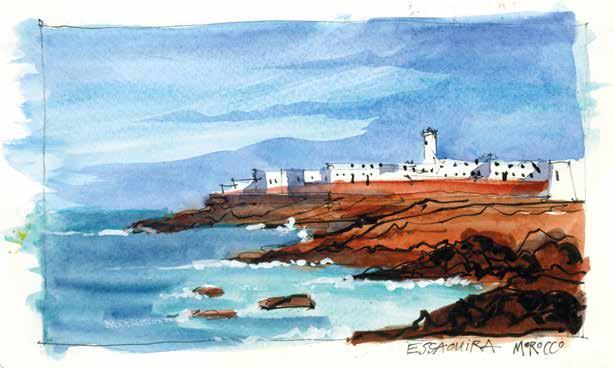
Essaouria, Morocco.
These are my must-haves for a trip:
• An Etchr Perfect Sketchbook, size B5 (roughly 7 × 10 inches), portrait format.
• Fine line pen with waterproof ink
• A fude nib fountain pen with waterproof ink
• A .07 mechanical pencil for line sketching
• Gray Polychromos colored pencil for heavier line sketching
• White gel pen.
• Brush Pens in light, medium and dark gray
• Metal travel watercolor palette filled with my own color choices:
• Cobalt Teal Blue, Ultramarine, Jadite Genuine, Deep Scarlet, Azo Yellow, Cobalt Blue, Deep Sap Green, Mayan Orange, Hansa Yellow Deep, Burnt Umber, Burnt Sienna Light, Opera Rose, Naples Yellow, Prussian Blue, Alizarin Crimson.
• Travel brushes, nos. 3, 6, 12 round.
• Small hand-held pencil sharpener.
• A few random colored pencils.
• Glue stick for pasting in ticket stubs, stamps and other “found objects”
• A few folded paper towels
• Small leakproof plastic container for water
• Lightweight folding stool
• Ecuadorian Panama Fedora
• cool sunglasses
• corkscrew

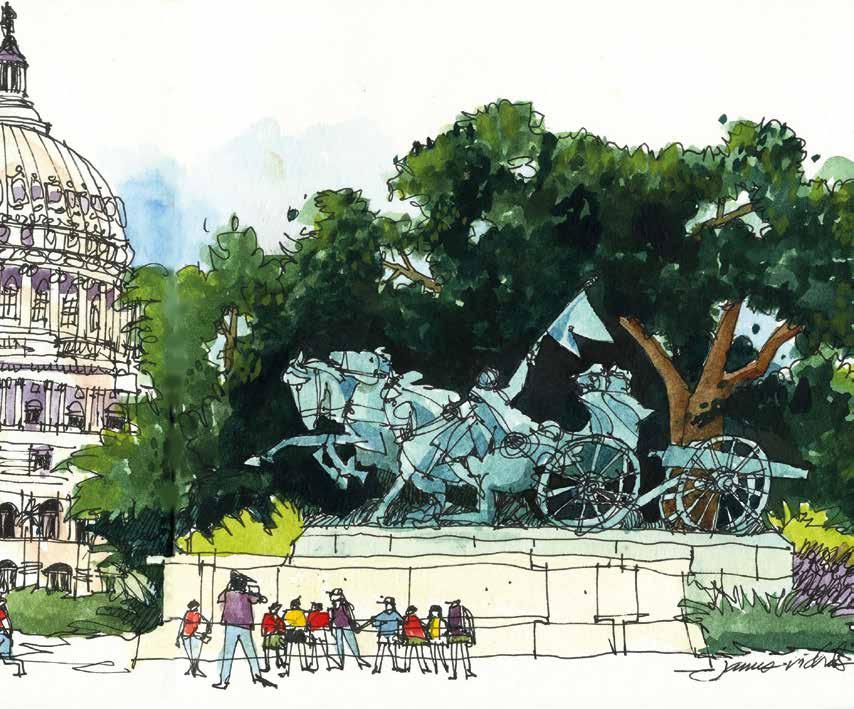
Don’t aspire to be great. Aspire to be prolific. If you’re prolific, becoming great takes care of itself.
That’s right. Want to get good? There’s a secret. Do it all the time. Period. That’s it.
Carry a sketchbook and pen with you. Commit to drawing in it every day.
Draw in ink. No erasing.
Draw anything. Draw a shelf of books, the view out the window, a tree in the park, your own hand. Tell yourself, “This is just for practice” to nip perfectionism in the bud.

Repeat.
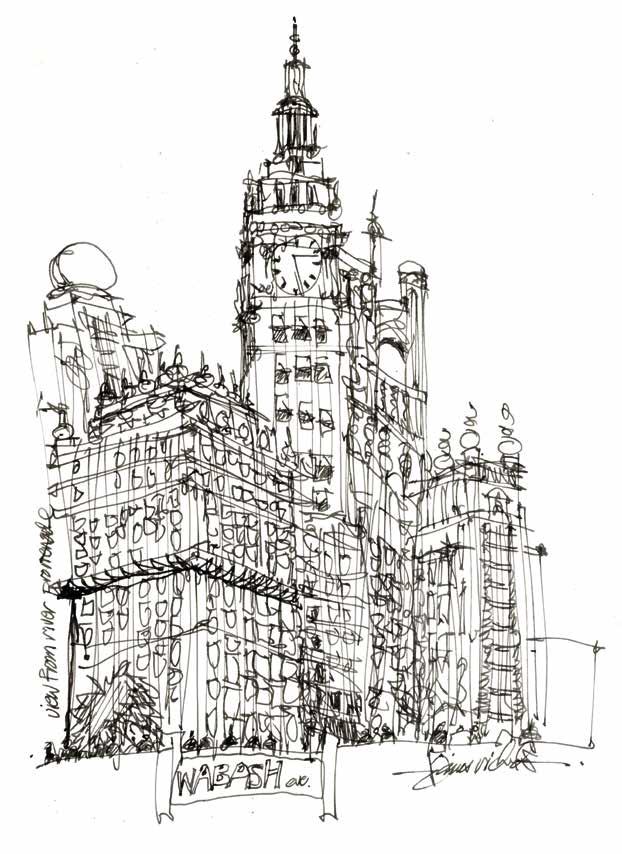
Opposite: Travel is an incomparable teacher, and sketching brings to it heightened awareness, a sense of purpose and a real creative rush.
The loose, line-driven styles of these three and the life of travel they drew hit me at a gut level—I’d discovered my native language. But I was also struck by the fact that all three were pretty good writers—their words and drawings complemented each other in ways that pulled me in and made for rich storytelling. They were more than illustrators. They were authors who drew. “Yeah,” I thought, “that ’ s a good job!”
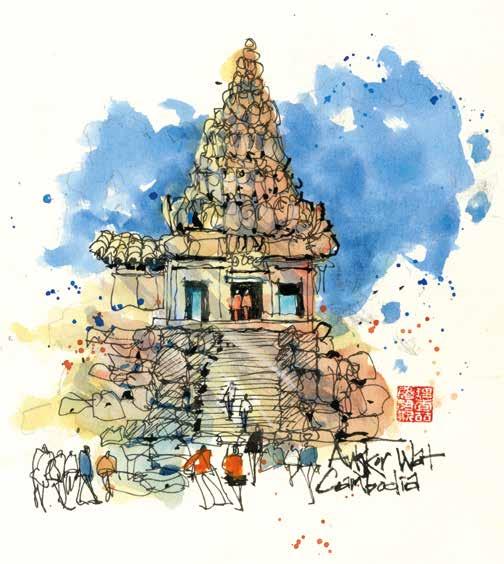


The silhouette of San Gimignano seems to grow organically and elegantly from the stunning Tuscan landscape.
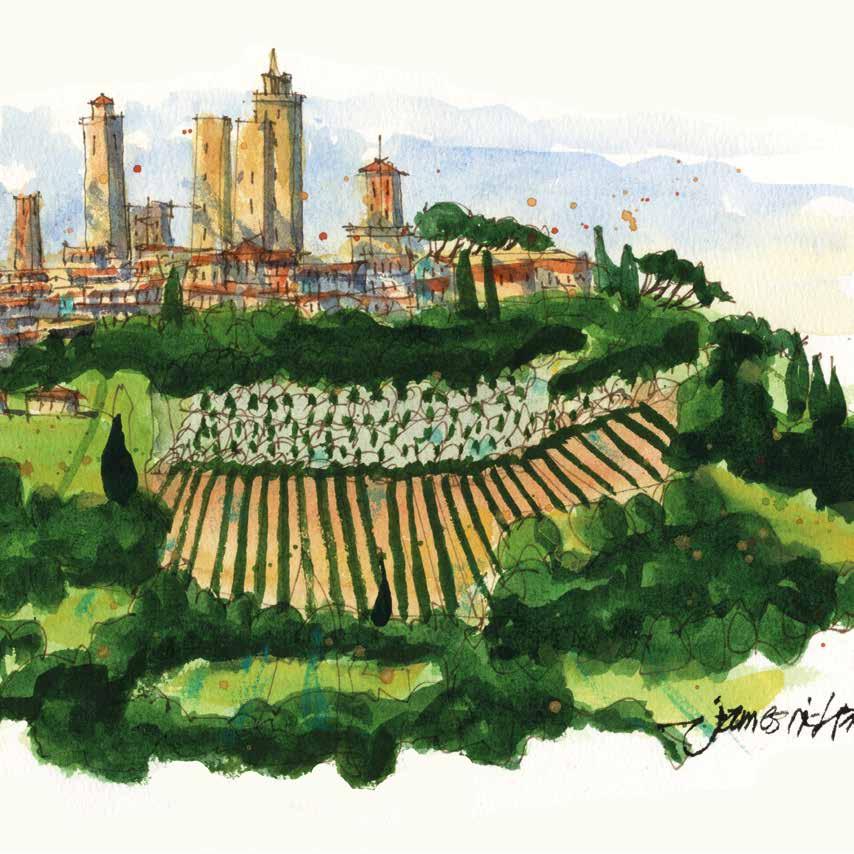
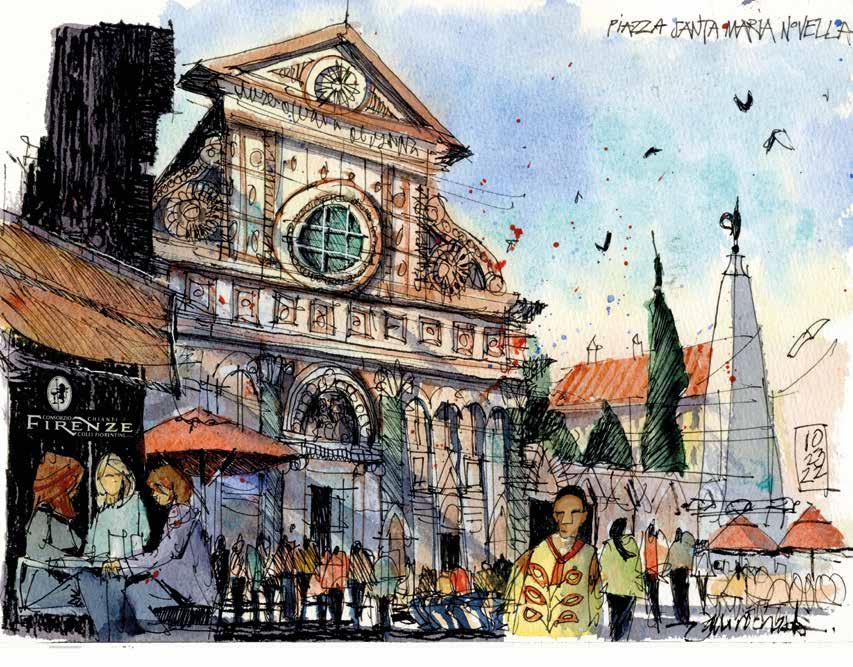

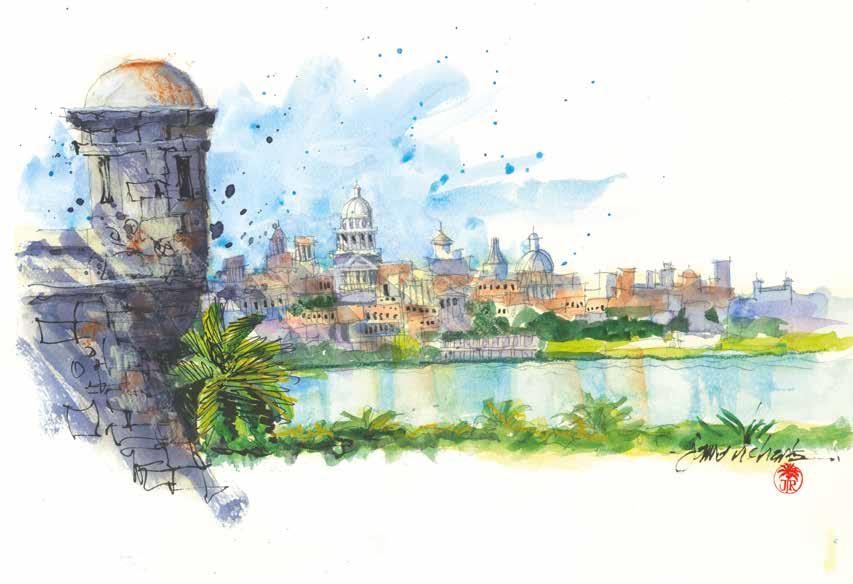
C HAPTER 4
Standing in th E customs interrogation room of Havana’s Jose Marti International Airport, I knew three things to be true:
1. My large, tightly packed box of 13 framed paintings, fresh from my three-week solo exhibition “Hemingway’s Cuba,” had been confiscated.
2. My payment for a bribe of unspecified amount requested by our gate agent clearly hadn’t been enough.
3. The customs agents who had followed me into the room were not happy.
The room was bare except for a desk, the uniformed woman behind it, and a single empty chair. There might have been the single bare lightbulb hanging from the ceiling like in the movies, or I may just reimagine it that way. The expression and body language of the agent behind the desk conveyed clearly that whatever trouble I was in was serious. The gravity of the situation hit me. My romantic notion of being an artist traveler in the footsteps of my drawing heroes never included jail time in Cuba.
The agent behind the desk spoke sternly in the distinctly Cuban dialect of Spanish that was beyond the very limited grasp of the language I had from school days. I responded with my well-practiced phrase, “Lo
Our first excursions in the pangas were a lesson in sketching from small open boats in choppy seas— a humbling experience. Gray whales seemed to be everywhere we looked.
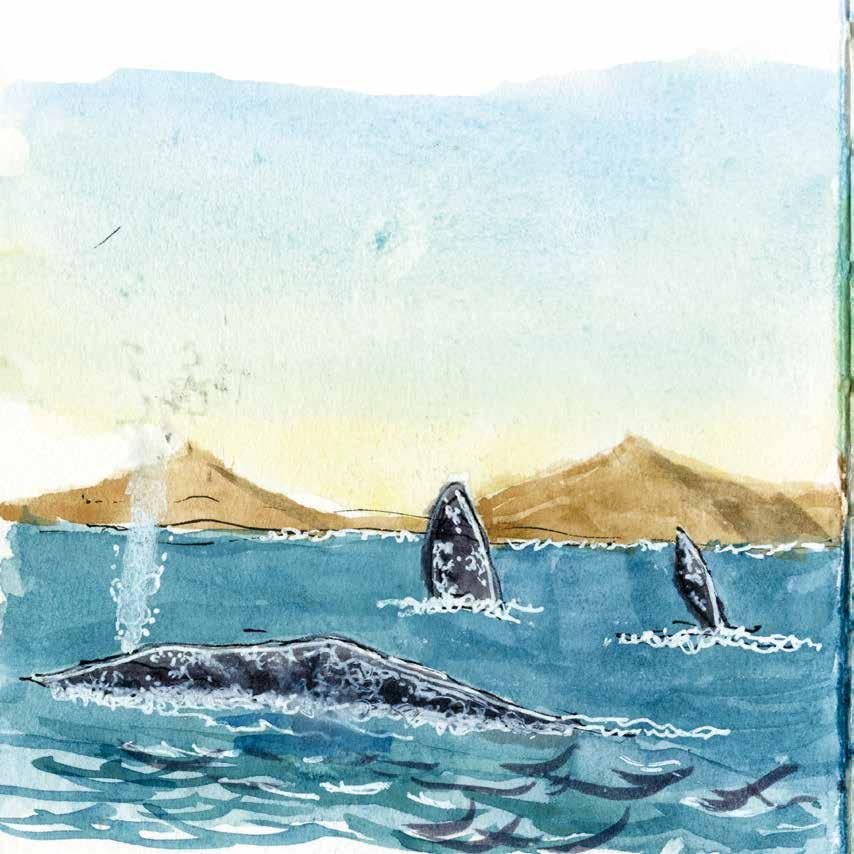
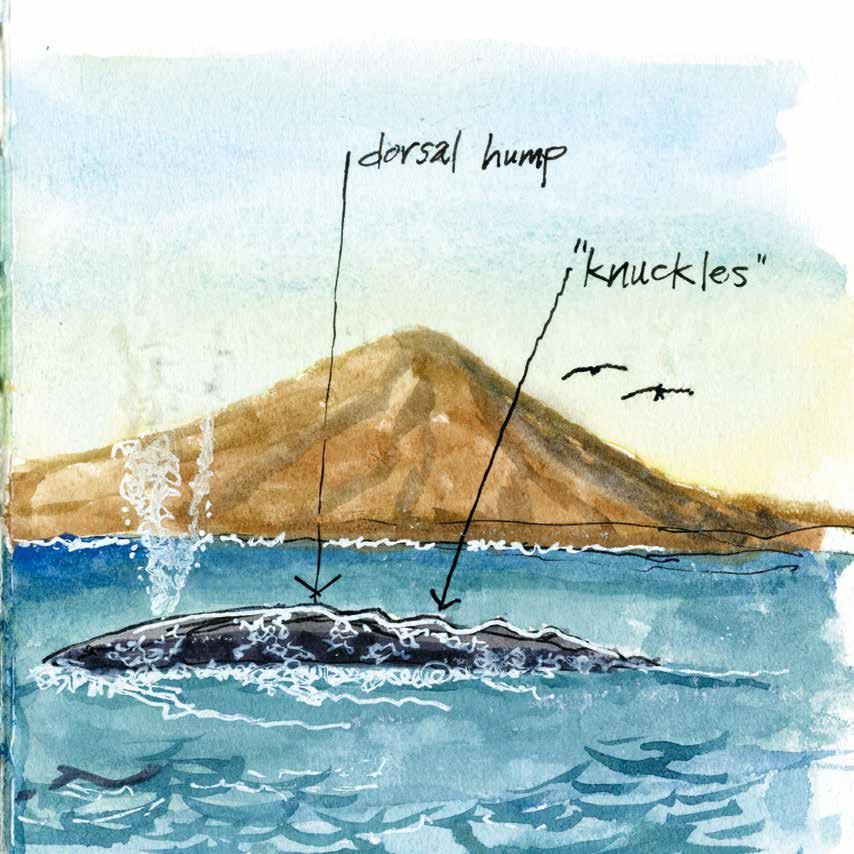
I was once asked in an interview if I thought my quick, rough sketches and preliminary studies were worthy of being final pieces in and of themselves. “Do you ever consider them actually better than the more finished works?” And of course, for my tastes, the roughs usually are better. I mentioned that I had a few artist friends who kept me honest when my “more finished works” were losing the life and spirit of the rough stuff. One of those friends used an on-the-spot drawing of a market tent I’d hurriedly drawn in Nairobi to make the point:
“This really embodies the style of yours I fell in love with— the expressive and flowing realism. The looser style has a vibrancy and energy to it. It communicates a lot more emotionally and energetically. I feel pulled in, and like I’m witnessing your inner voice as an artist, and a sense of joy that’s captured in the making.”
And there, in four sentences, she nailed it. She had simultaneously bitch-slapped me and held up a mirror. I had to think about why the rough sketches looked so much more alive. I found myself thinking about child’s play. That is, when I think of the drawing I’m jumping into as play—unselfconscious, without judgement—the joy I’m feeling comes out in the work. My guard is down, I’m having fun, and it shows.
When I draw out of a sense of obligation and angst—say, for a commission—that shows too. I tighten up and second guess. The resulting piece inevitably looks a little (or a lot) stiffer, overworked. It becomes like taxidermy, an okay simulation of the thing on the outside, but dead inside. When I’m really on having fun, the moves and the lines come rushing out of me before I have time to think about them. The difference can be astounding. So, it’s helpful to get your head in the right place. When I’m drawing, the medium or tools aren’t the secret. Rather, it’s when I feel like I’m playing that the drawing comes alive.
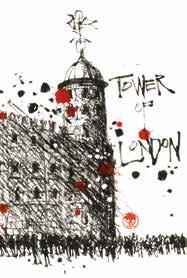

This quickly scrawled sketch of the Tower of London with tourists milling about was a joy to create, and the drawing reflects that sense of fun. Hearing gory tales of torture and execution with my young grandsons gave me an opening to throw on “blood” splatters. The boys approved.
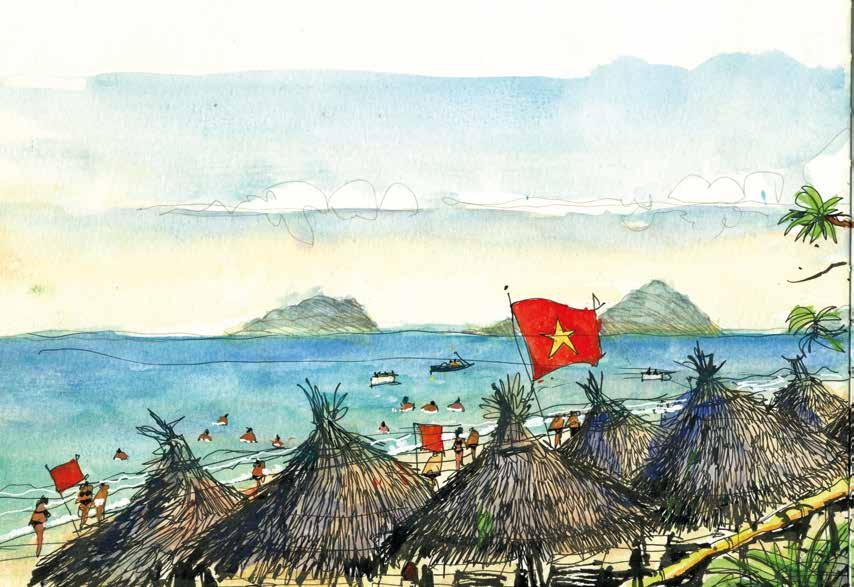
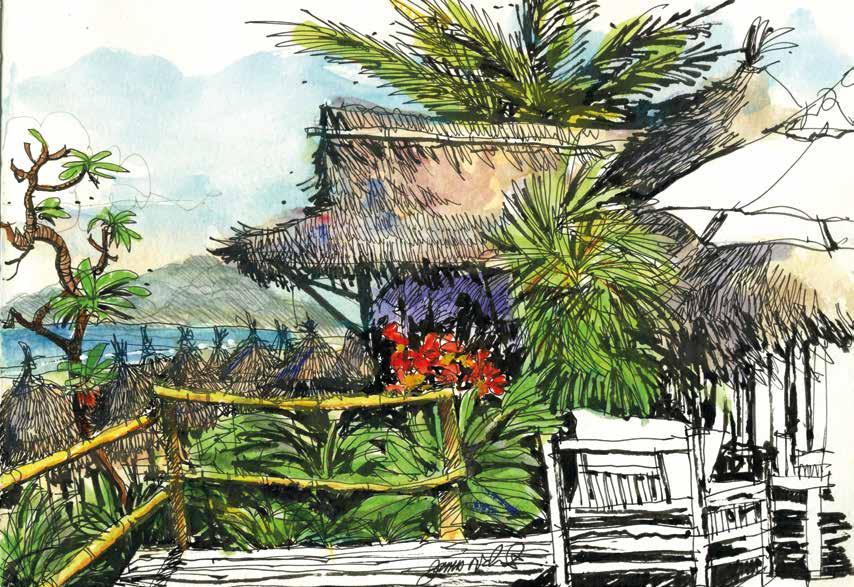
This beautiful white crescent of sand at Danang was dubbed China Beach by U.S. soldiers during the Vietnam War, and was the first landing spot for American combat troops. It’s now An Bang Beach, with luxury resorts and public beaches looking out onto the breathtaking views.

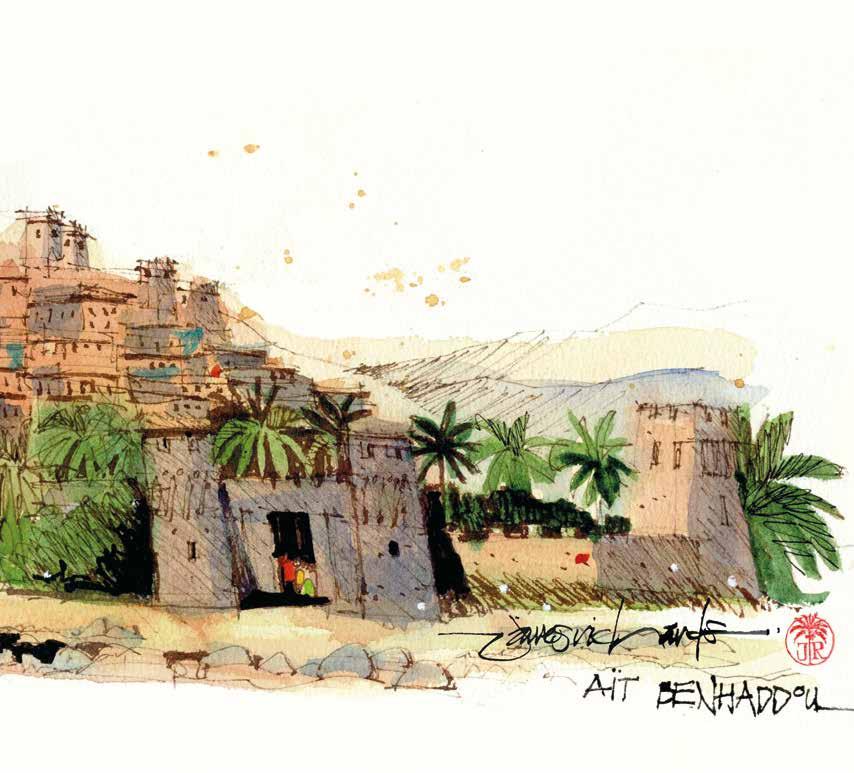
Aït Benhaddou is a ksar, or a fortified earthen clay village along the old caravan route between the Sahara and Marrakesh. Over one thousand years old, it provided settings for Lawrence of Arabia, Gladiator, The Mummy, Game of Thrones and many other films and television shows.
Another window into Key West’s quirky culture is the curious but not really surprising story of the founding of the Conch Republic, when Key West briefly seceded from the United States in protest over a U.S. Border Patrol roadblock on U.S. 1, the single, thin ribbon of roadway connecting the island to the mainland. Vehicles were stopped, occupants questioned, and searches for drugs and illegal aliens ensued, much as would happen at a border crossing into (or out of) another country. These actions, of course, backed up traffic for miles, greatly inconvenienced the residents of the Keys and put a serious dent in Key West’s tourism. After repeated complaints from the Key West City Council and failed attempts to get an injunction of the roadblock, the mayor and council reasoned that if they were to be treated as a foreign nation, they might as well become one. Accounts of what happened next vary slightly, as the events occurred some time ago and there was alcohol involved, but this is my favorite version.
In the course of a day, Key West citizens condemned the action, declared the island the independent Conch Republic, and symbolically attacked the U.S. Navy by breaking a loaf of stale Cuban bread over the head of a man in a naval uniform. One minute later, the new Conch Republic surrendered to the same uniformed man and promptly applied for foreign aid. It seemed a perfectly reasonable and appropriate thing to do in 1982 Key West. Come to think of it, it would probably seem so now.
The spirit of the Conch Republic lives on, mostly as a local point of pride and tourism ploy. The secession event is commemorated every year with a festival, and Conch Republic merchandise can be purchased at any number of spots on or near Duval Street. The Grown-up and I are proud holders of official Conch Republic passports— honored in at least one Caribbean nation—and the nation’s flag hangs on our living room wall. At the end of the day, it’s more a state of mind than sovereign nation, and my mind has a thatch umbrella, hammock and umbrella drink there.
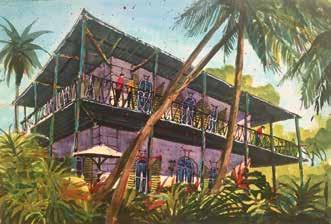
907 Whitehead Street, Ernest Hemingway’s residence from 1931 to 1939, where he wrote some of his best novels and short stories.
